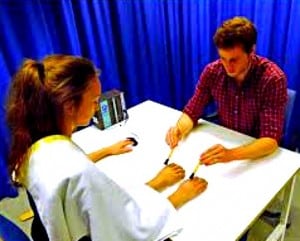
The researchers observed how people with ASD and people without ASD reacted to the rubber-hand illusion. For the illusion, subjects kept one of their hands out of sight. A rubber hand was positioned in front of them. Researchers stroked the subject’s real hand and the rubber hand simultaneously, which created the illusion that the rubber hand is the subject’s real hand. Then, the subjects were asked to reach out and grasp an object with their hand.
The subjects’ hand movements were disrupted by the experience of the illusion. The subjects most affected by the rubber-hand illusion were those with the lowest levels of autism-related traits. People with ASD fell for the illusion, but they were more likely to resist the illusion’s effects when they reached out for the object. This suggests that autistic brains may not make decisions based on background information and context in the same way that non-autistic brains do.
The findings suggest yet another way that the brains of people with ASD differ in their interactions with their environments. The study also corroborates other work indicating that people with ASD have impaired predictive abilities.
Colin Palmer, PhD student from Monash University’s School of Philosophical, Historical and International Studies, who was involved with the study says of the findings, “The study suggests that individuals may differ in how their brains draw upon contextual information when perceiving and interacting with the world. This could contribute to sensory and movement difficulties, which are commonly experienced in autism.”
This research is published in the Proceedings of the Royal Society B.
Previous news in autism:



 © 2025 Unyte Health US Inc.
© 2025 Unyte Health US Inc.